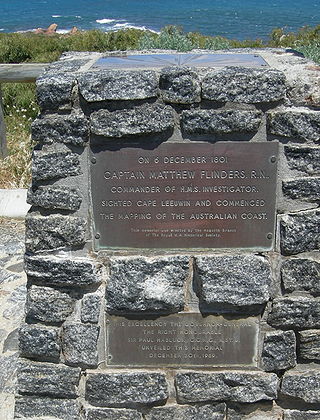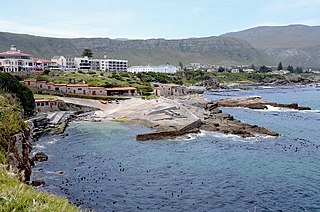
The Natural History Museum in London is a museum that exhibits a vast range of specimens from various segments of natural history. It is one of three major museums on Exhibition Road in South Kensington, the others being the Science Museum and the Victoria and Albert Museum. The Natural History Museum's main frontage, however, is on Cromwell Road.

The Museum of Natural Sciences of Belgium is a museum dedicated to natural history, located in Brussels, Belgium. The museum is a part of the Royal Belgian Institute of Natural Sciences. Its most important pieces are 30 fossilised Iguanodon skeletons, which were discovered in 1878 in Bernissart, Belgium.

Inverloch is a seaside town located in Victoria, Australia and the most populous city of the Bass Coast Shire. It is located 143 kilometres (89 mi) south east of Melbourne via the South Gippsland Highway on the Bass Highway in the Bass Coast Shire of Gippsland, Victoria, Australia. Known originally for the calm waters of Anderson Inlet, it is now also known for the discovery of Australia's first dinosaur bone.

Struisbaai is a coastal town in the Overberg region of South Africa's Western Cape province. The town is in the Cape Agulhas Local Municipality in the Overberg District, about two hundred kilometres south east of Cape Town, and four kilometres from Cape Agulhas, which is the southernmost point of the African continent.

Gansbaai is a fishing town and popular tourist destination in the Overberg District Municipality, Western Cape, South Africa. It is known for its dense population of great white sharks and as a whale-watching location.

Flinders Bay is a bay that is immediately south of the townsite of Augusta, and close to the mouth of the Blackwood River.

Hermanus, is a town on the southern coast of the Western Cape province of South Africa. It is known for Southern Right whale watching during the southern winter to spring seasons, and is a popular retirement location.

Spiekeroog is one of the East Frisian Islands, off the North Sea coast of Germany. It is situated between Langeoog to its west, and Wangerooge to its east. The island belongs to the district of Wittmund, in Lower Saxony in Germany. The only village on the island is also called Spiekeroog. The island is part of the Wadden Sea World Heritage Site by the UNESCO and the Lower Saxon Wadden Sea National Park.

The Museum of the Earth is a natural history museum located in Ithaca, New York. The museum was opened in 2003 as part of the Paleontological Research Institution (PRI), an independent organization pursuing research and education in the history of the Earth and its life. Both PRI and the Museum of the Earth are formally affiliated with Cornell University. The Museum of the Earth is home to Earth science exhibits and science-related art displays with a focus on the concurrent evolution of the Earth and life.

The McGregor Museum in Kimberley, South Africa, originally known as the Alexander McGregor Memorial Museum, is a multidisciplinary museum which serves Kimberley and the Northern Cape, established in 1907.

The Iziko South African Museum is a South African national museum located in Cape Town. The museum was founded in 1825, the first in the country. It has been on its present site in the Company's Garden since 1897. The museum houses important African zoology, palaeontology and archaeology collections.
Fisherhaven is a suburb of the whale watching town of Hermanus in the Western Cape, South Africa. It is situated next to the Bot River Lagoon, about 14 km from Hermanus center and about 14 km from Arabella Country Estate and Golf course. There is an abundance of indigenous fauna and flora.

Angling in Yellowstone National Park is a major reason many visitors come to the park each year and since it was created in 1872, the park has drawn anglers from around the world to fish its waters. In 2006, over 50,000 park fishing permits were issued to visitors. The park contains hundreds of miles of accessible, high-quality trout rivers containing wild trout populations—over 200 creeks, streams and rivers are fishable. There are 45 fishable lakes and several large lakes are easily accessible to visitors. Additionally, the park's remote sections provide anglers ample opportunity to visit rivers, streams, creeks and lakes that receive little angling pressure. With the exception of one specially designated drainage, all the park's waters are restricted to artificial lures and fly fishing. The Madison, Firehole and a section of the Gibbon rivers are restricted to fly fishing only.
This page is a list of fishing topics.

Pakistan Museum of Natural History (PMNH), (Urdu: عجائب خانہ جاتِ پاکستان برائے طبعی تواریخ) established in 1976, is a public natural history museum situated in Islamabad, the federal capital of Pakistan.

The Húsavík Whale Museum is a non-profit organization established in 1997. The Húsavík Whale Museum is situated in Húsavík, a small town in north east Iceland, on the shores of Skjálfandi Bay, just below the Arctic Circle at 66° N. It began as a small exhibit on whales in the town's hotel in summer 1997. Shortly after that, the exhibition was moved into the newly renovated part of the baiting shed at the harbor and the shareholding business “Húsavík Whale Centre ehf” was established. Due to the growing popularity, it was obvious that a larger and more suitable building was needed after only 3 years. In 2000, the town's old slaughterhouse was purchased, remodeled, and officially opened in June 2002. In 2004, the shareholding business turned into a non-profit organization and was renamed “The Húsavík Whale Museum.” By 2005, a comprehensive exhibition on the ecology of whales was added.

Fishing in Cornwall, England, UK, has traditionally been one of the main elements of the economy of the county. Pilchard fishing and processing was a thriving industry in Cornwall from around 1750 to around 1880, after which it went into an almost terminal decline. During the 20th century the varieties of fish taken became much more diverse and crustaceans such as crab and lobster are now significant. Much of the catch is exported to France due to the higher prices obtainable there. Though fishing has been significantly damaged by overfishing, the Southwest Handline Fishermen's Association has started to revive the fishing industry. As of 2007, stocks were improving. The Cornwall Sea Fisheries Committee is one of 12 committees responsible for managing the corresponding Sea Fisheries District. The Isles of Scilly Sea Fisheries Committee is responsible for the Scilly district.

The Natural History Museum of Bern is a museum in Bern, Switzerland. In its teaching and research it cooperates closely with the University of Bern. It is visited by around 131,000 people yearly.

The Reykjavik Maritime Museum, formerly Víkin Maritime Museum, is a maritime museum located by the old harbour in the capital of Iceland, Reykjavík and run by Reykjavik City. The museum was established in 2005, and it is now one of five sites belonging to Reykjavik City Museum. There are seven exhibitions at the museum displaying Icelandic maritime history from the early settlements to the late 20th century. An important part of the museum is the Coast Guard and rescue vessel Óðinn. In 2008, the ship was transformed into a museum exhibit about the cod wars in the 1950s and 1970s. The ship also tells about its own history. The museum focuses on the history of fishing in Iceland but also displays temporary exhibitions related to the sea.

The London cast of Dippy is a plaster cast replica of the fossilised bones of a Diplodocus carnegii skeleton, the original of which – also known as Dippy – is on display at Pittsburgh's Carnegie Museum of Natural History. The 26-metre (85 ft) long cast was displayed between 1905 and 2017 in the Natural History Museum in London, becoming an iconic representation of the museum. It began a national tour of British museums in February 2018. Dippy returned to London in June 2022, and then moved to Coventry as a long-term loan to the Herbert Art Gallery & Museum in 2023.




















